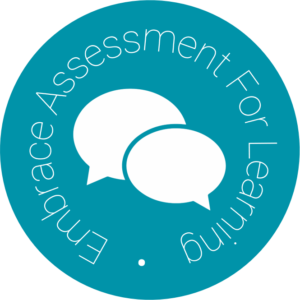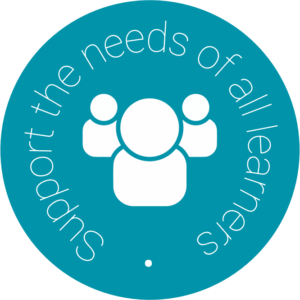The CASE model
There are four key themes to our model for thinking about effective blended delivery, Consistency, Accessibility, Scaffolding and Engagement, and they are distilled from the wider research, experience, and good practice in blended learning and teaching. Course teams should keep these in mind when designing activities for your students, helping you make choices which promote effective learning experiences for all students. The themes also encourage us to make the most of the opportunities presented by blended approaches to provision, such as supporting engagement, collaboration, and autonomy in learning.
Explore the themes below:
Students’ experience of learning and teaching activity is consistent and structured across their course and individual units.
Key benefits
- Consistency and clarity can lead to fewer questions of staff about administrative issues (e.g. what is my assessment deadline/where do I submit my assignment?)
- Using a clear template on Moodle enables course teams to structure and populate their course and units to benefit all their students and can save staff time by not having to develop the approach from scratch.
It is no coincidence that most online learning providers (such as Wiley – Bath’s chosen partner) use clear, consistent and well-structured courses to guide online learners through content and activities.
Well-structured content, which makes clear to students what they are expected to do and by when, can support students to work independently (when accompanied by a course-wide approach to developing independent and active learning).
Clear and consistent availability of information enables students to better understand and locate course content and resources, their assessment deadlines, and how and when they need to communicate with tutors and fellow students. This in turn can lead to students asking fewer questions of staff as the information they need is visible and easy to find.
Research has demonstrated that clear and consistent standards for online courses (e.g. design, layout, and structure) can help lead to an increase in student satisfaction (Beetham & White, 2013; Reed & Watmough, 2015; UCISA, n.d.).
Standards such as the ready and consistent availability of administrative and teaching information on the VLE can be a useful engagement tool to start conversations about learning and teaching practice.
– UCISA (professional body for digital practitioners within education)
Key design considerations
- The choice of blended delivery methods and activities should be broadly consistent within each course and developed in collaboration with all contributing departments.
- Each course should follow the same Moodle design across its units.
- Provide links to Zoom/Teams meetings in the same place, avoiding student confusion and saving time.
- It is helpful to provide a weekly summary of activities and deadlines to help students manage their time and prioritise effectively. This also help staff assess whether the volume of work is appropriate.
Key resources
The Bath Blend Baseline promotes a consistent experience for all students.
Moodle spaces clearly display key course information from our data systems in a uniform way and allows for manual entry where needed (as more data sources become available, we will add these over time). Moodle templates can be applied to provide key headings and resources whilst also providing staff with a guide to how a course should be structured. Staff will retain the flexibility to add content, activities and resources as befits their discipline, but within the framework of the template to ensure consistency across their courses.
How Moodle can help
Consistency, structure and layout of courses benefits by the provision of clear templating (Berkel et al., 2010, p. 121). Moodle units will, as a minimum, be consistent across a course with clear:
- Structure and Navigation e.g. activities and resources are labelled and sequenced in a logical order and contain key information at a glance.
- Communication Statement e.g. informing students how they will be expected to communicate with both their tutor and other students, and how their tutors will communicate with them.
- Commitment to Accessibility e.g. resources are digitally accessible.
Learning opportunities are inclusive and available to all students regardless of their mode of study and learning needs.
Key benefits
- Accessible content is inclusive, enabling students to prioritise and manage their work, revisiting material in their own time, developing their independence and ability to take responsibility for their own learning.
- Well-designed blended provision can provide enhanced flexibility for all students and staff.
- Blended provision can overcome many of the barriers to accessibility faced on campus.
It is vital that all students can access their teaching and learning activities and resources in order to engage fully with and participate in their course.
Accessible design ensures that everyone can access content easily – be it unassisted, or via assistive technologies (such as screen readers and electronic braille).
When content (such as MS Word and PowerPoint presentations) is accessible, all learners can benefit from finding and processing information more easily, making the learning experience deeper and more engaging (Connect, 2018).
…inclusive learning and teaching recognises students’ entitlement to a learning experience that respects diversity, enables participation, removes barriers and anticipates and considers a variety of learning needs and preferences without directly or indirectly excluding anyone.
– AdvanceHE
Key design considerations
- Identifying and anticipating student needs in advance so that they can be embedded in course and content design.
- Learning materials are made available at the appropriate time (for example, a pre-work video is made available in good time before a LOIL session which will draw on its content).
- Learning and teaching activities are aligned with the technology that students have available.
- Ensuring all students can interact and contribute to teaching activities and have opportunities to practice using different tools.
- Awareness of accessibility legislation and copyright guidance.
- Consulting with relevant services such as the Library to ensure appropriate numbers of online resource and software licences are available.
Key resources
The Bath Blend Baseline sets out simple guidance on accessibility on Moodle, and our Digital Accessibility page contains more detailed guidance on tools, tips and approaches that can be adopted. There is specific guidance on how accessibility affects STEM subjects. Staff (and students) can also approach the Assistive Learning Technologists in DDAT for one-to-one support and guidance. Other Professional Services teams also have vast expertise and resources available to support teaching and learning provision.
Learning is explicitly structured, sequenced, and supported to promote the effective development of students’ understanding and skills, with clear opportunities to support learning.
Key benefits
- Reinforce learning of content and skills across and between units.
- Develop greater independent learning skills and attitudes.
- Opportunities to review and reduce unnecessary or duplicated content and summative assessment.
How course content is selected, organised, presented, and assessed has a huge impact on the quality of learning achieved (Laurillard, 2012). For instance, activities that are carefully designed can engage students, creating a learning environment in which they can practice and develop understanding and skills.
A clear pattern of delivery shows how and when staff will provide active contact and engagement, as well as the expectations for students’ own responsibilities for their learning. This can help to nurture learners’ motivation and independence through which they begin to work out how to improve for themselves.
…trigger a shift from content-driven curricula (the idea of ‘covering content’) to carefully structured and selective bite-sized lectures with engaging tasks which help students get to grips with concepts.
– Tansy Jessop, Wonkhe, 2020
Key design considerations
- Course and Unit Intended Learning Outcomes can be met regardless of the blended mode of provision.
- The scope and content of units is suitable for a blended environment and assessment is only undertaken where necessary and can be undertaken online.
- A teaching team is formed and collaborates closely on the course design and delivery.
- Professional support services are engaged in course development and, where they contribute to course delivery, their role is clearly defined (for staff and students).
- Formative assessment opportunities are available, including development of learner independence through self and peer assessment activities.
Further considerations:
- Students are provided with a clear structure of their course, including the pattern of learning and teaching activities across all units.
- Students are supported as they transition into blended learning and as they develop new skills, such as how to do groupwork online, how to participate in discussions and how to approach assessment online.
- Student expectations are made explicit across the course, including shared understanding and expectations of what formative feedback will be provided and how this will help prepare them for specific summative assessment tasks.
Key resources
A backwards design approach begins with clear and robust Course Intended Learning Outcomes, using these to choose appropriate assessment methods and teaching and learning activities.
Students are empowered in their studies, with delivery focused on embedding collaboration, discussion, and interactive learning activities.
Key benefits
- Opportunities to foreground active learning through student interaction and collaboration.
- Can provide more opportunities for reflection.
- Increased flexibility.
- More diverse learning opportunities can be created, without timetabling restrictions.
Successful blended learning environments allow all students to actively participate and collaborate as part of a community in which they interact with peers, tutors, teachers, and other support services.
Online teaching requires a greater need to intentionally design our activities to facilitate ways in which different voices can speak and be heard, and to explicitly communicate our expectations to students.
If [teachers] foster a sense of self-efficacy, encourage a balance of orientations to study, and use educational practices that engage, nurture, and challenge their students, their students can develop the confidence to become effective learners.
– Diana Laurillard (2012)
Key design considerations
- Teaching and learning activities are designed for engagement not just content.
- Staff require time and support to redesign resources and scaffold content to encourage participation and progress.
- A clear plan for engaging all students in their learning (including transition into blended learning modes).
- Courses integrate with/signpost to relevant support and networks across the University.
- A clear plan for gathering feedback from students on their course experience (in addition to regular SSLC meetings and online unit evaluations).
- A clear plan for communicating with students before and during their course, including expectations for staff and student engagement.
Key principles for design
The CASE themes build on our broader curriculum principles. The principles provide the starting points for design thinking to promote coherent approaches to the design of course outcomes, assessment, and activity.


